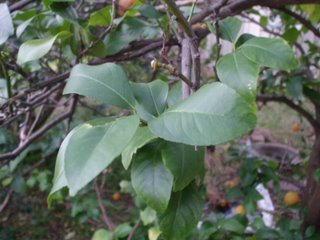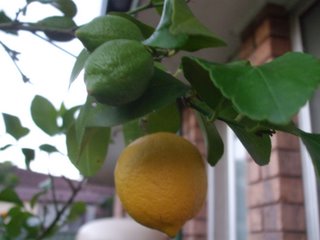
Why is it that lemon trees are so useful, but so easily give up the ghost? Every household should have a lemon tree and it’s very frustrating when your carefully planted and lovingly nurtured tree expires without producing the goods. Obviously all I have is my backyard and not a large orchard area but I have still managed to kill two lemon trees before i found out what I was doing wrong and saved the third. My other citrus trees (lime; Kaffir lime; orange; mandarine and lemonade) are OK but the lemons persisted in dying.
The manner in which leaves go yellow can tell a lot about what is wrong with the tree, but without more detailed information about your particular circumstances I can suggest theee things that may be wrong –
WET FEET
If the draining on your land is poor, there is plant of clay or marl (I’m on good old Sydney clay) or there is some other reason why water cannot get away, your lemon’s roots will remain wet. This encourages the fungus phytophthora citrophthora which causes root rot. The symptoms of this are that the leaf veins yellow first, leading to general yellowing and leaf fall and the tree may eventually die. Phytophthora resistant root stocks such as Trifoliata may help but removal of the cause by improving drainage is the real answer. If you think this may be a problem before you plant, build the soil up and make a raised bed to improve the drainage and give yourself a chance from the beginning.
INCORRECT SOIL pH
Using a soil pH meter or chemical pH test kit is the best way to diagnose this problem. The best soil pH for lemon trees is probably 5.5 to 6.5 although this range is also favourable to phytophthora. If the pH is too low (ie the soil is acid) dolomite or agricultural lime (calcium carbonate) will raise it. If the pH is too high, which can be due to previous over-liming, a condition called lime-induced chlorosis can occur. This is cause by iron in the soil being chemically bound and unavailable to the plant at the high pH. This causes the reverse of wet feet, the leaves are yellow but the veins remain green; again leaf fall and death can result. To reduce the pH powdered sulphur, alum (aluminium sulphate), sulphate of ammonia or large doses of organic matter may be used.
NUTRIENT DEFICIENCY
Plants require a number of chemical elements to function properly and a soil which is rich and good for growing plants and trees contains all these things. If only one of these elements is in short supply or absent the whole tree may suffer in the same what a person may suffer from a vitamin deficiency. Each deficiency has its own symptoms, which can be summarised as follows –
• Nitrogen – Leaves are pale green and new growth is small, old leaves fall readily.
• Phosphorous – general bronzing of the foliage
• Potassium – “burnt leaf” occurs, a banded pattern with leaves being green at the base, then yellow, then brown then dead at the tip. The old leaves fall readily.
• Magnesium – Yellow leaf and leaf drop develop as the fruit ripens.
• Zinc – mottling of the leaves and reduction in size of the new leaves (“little leaf”), worst on the sunny side of the tree.
• Manganese – mottling also occurs, worst on the shady side of the tree, leaf size is normal but if deficiency continues small, curled and beaked leaves develop.
• Boron – The fruit appears lumpy and water soaked spots occur in the leaves.
• Sulphur – similar to phosphorous or nitrogen deficiency with mid-rib yellowing.
To correct the deficiencies the element may be added by itself eg magnesium sulphate (Epsom Salts) if you suspect a magnesium deficiency, or add a trace element mix or seaweed solution for the minor elements, chook poo is high in nitrogen, potassium and phosphorous if these are what you need.
Long live your lemon tree!



